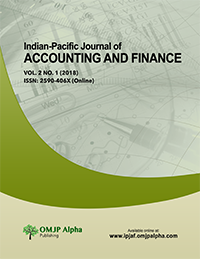Internal Audit Functions: An Empirical Study of Public and Private Sectors in Nigeria
DOI:
https://doi.org/10.52962/ipjaf.2018.2.1.1Keywords:
Internal Audit Function, Public Sector, Private Sector, Nigeria, ComparisonAbstract
The study examines the similarities and differences between the private and public sectors internal audit functions in Nigeria. The features examined include the hierarchical position of the internal audit functions, outsourcing of internal audit activities, reporting relationship of the internal auditor, and the coordination between internal and external auditors. A survey of internal audit managers of both sectors was undertaken to establish their current practices. The results revealed that there are no much differences in the hierarchical positioning of the internal audit function in both sectors. A substantial difference was found in the reporting lines of internal auditors in both sectors. The results further showed that private sector outsources internal audit activities more than the public sector and a slight difference exists between the two sectors about the level of coordination between internal and external auditors. Finally, the result indicated that private sector experiences a reduction in external audit fees compares to its counterpart in the public sector.
Downloads
Downloads
Published
Issue
Section
License
Site users
Copyright of all articles published in the Indian Pacific Journal of Accounting and Finance (IPJAF) belongs to their respective authors. Site users are permitted to download and print the articles for personal use. Further reproduction and/or distribution is not permitted, except for brief excerpts or quotations intended for inclusion in some other original works. In this case, proper attribution must be made to the author/copyright holder, and the place of publication must be acknowledged. Altering, editing or otherwise modifying the content of information obtained from the Indian Pacific Journal of Accounting and Finance (IPJAF) is a breach of copyright.
Authors
While you retain the copyright of your original material, by publishing in the Indian Pacific Journal of Accounting and Finance (IPJAF) , you will have agreed to the following contractual terms:
- The article is the original work of the stated author(s).
- The work has not been published previously.
- If the Article contains copyright material owned by others, written permission has been obtained from the copyright owner(s) to republish such material in any print or electronic medium and that you have included appropriate acknowledgement of such rights in the Article.
- The author agrees to grant a non-exclusive license to the Indian Pacific Journal of Accounting and Finance (IPJAF) to communicate the work to the public.
- The Indian Pacific Journal of Accounting and Finance (IPJAF) may use the article for publicity purposes.
- The Indian Pacific Journal of Accounting and Finance (IPJAF) may publish the article on third-party sites.
- Any subsequent publication of the article by the authors will carry the acknowledgement: First published in the Indian Pacific Journal of Accounting and Finance (IPJAF) [http://ipjaf.omjpalpha.com]
Disclaimer
The Indian Pacific Journal of Accounting and Finance (IPJAF) has taken all reasonable measures to ensure that material contained in this website is the original work of the author(s). However, the Journal gives no warranty and accepts no responsibility for the accuracy or the completeness of the material; no reliance should be made by any user on the material. The user should check with the authors for confirmation.
Articles published in the Indian Pacific Journal of Accounting and Finance (IPJAF) do not represent the views held by the editors and members of the editorial board. Authors are responsible for all aspects of their articles except the editorial screen design.







